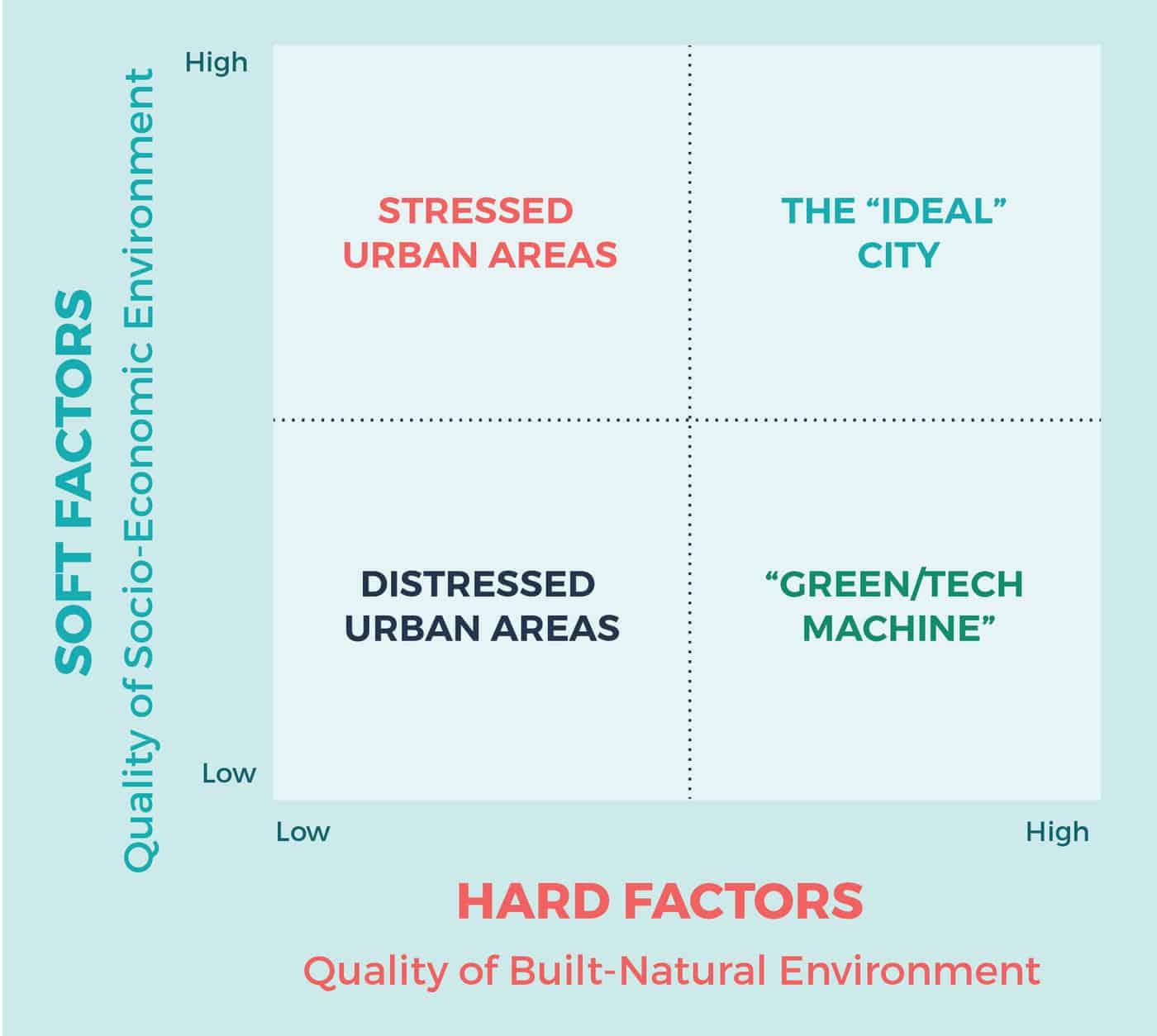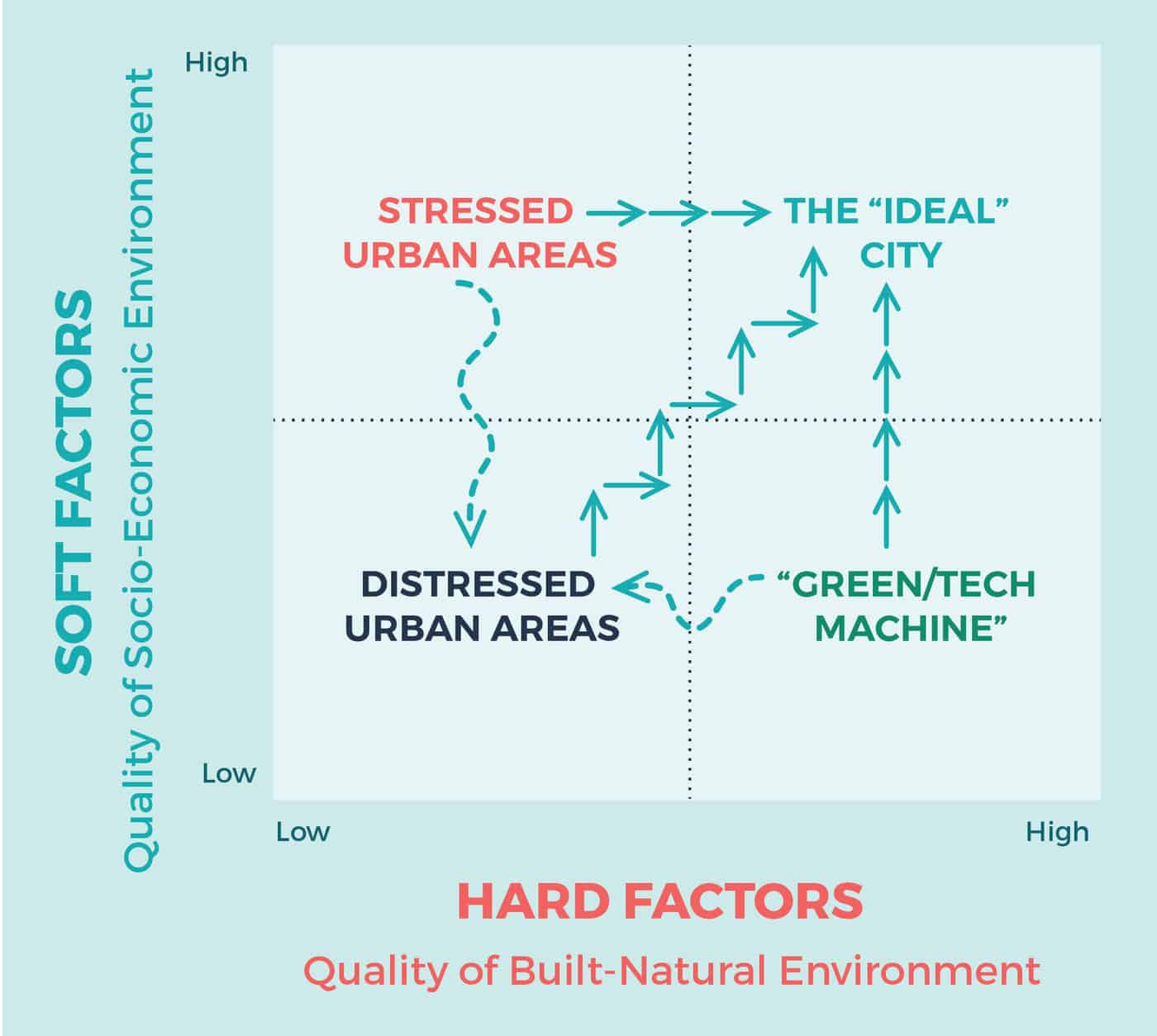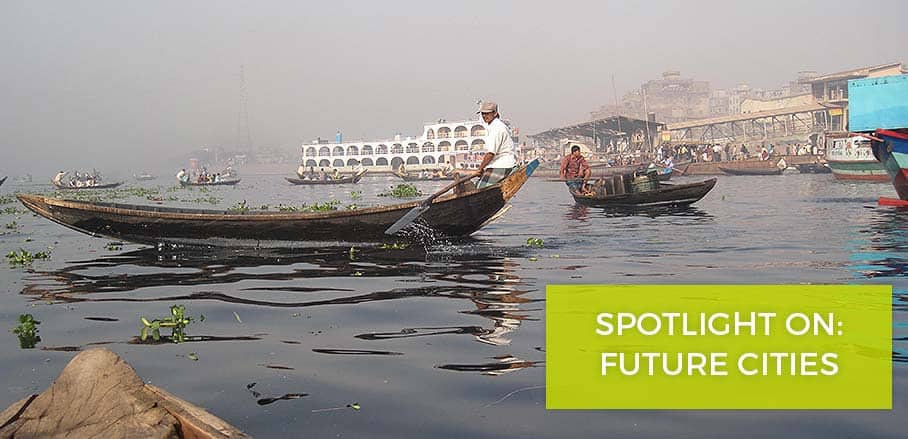What Characterises an Ideal City, and How Do We Get There?
By Marco Dall’Orso
What do we envision the ideal city of the future to be like? How can we approach such an ideal in urban planning? According to Marco Dall’Orso, the (re)creation of urban environments needs to balance and integrate multiple strategies. Taking into account the quality of the socio-economic and built-natural environment, he develops a framework that can be used to analyse a city’s strengths, weaknesses, and possible trajectories for future development.
Population growth, socio-economic trends, geopolitical events, the desire for a better life and more opportunities, are driving urbanisation across the world and particularly in developing countries and emerging economies. How can cities cope with this lumpy demographic growth? How can cities balance the short-term need to integrate new residents with the long-term goal to guarantee inclusive, safe, resilient and sustainable urban environments?
The rapidly growing demand for urban life is currently being addressed through regeneration of underutilised areas, urban sprawl or the creation of new developments and cities. Obviously, these are just some of the “easy” built-environment options and provide only a partial answer to the problem. The very tough questions posed here are: How can great inclusive places be created? How can healthy urban environments be forged to provide opportunities for interaction and for personal and professional growth? How can effective socio-economic solutions be identified and executed to complement the “physical dimension” of built environments?
To be a winner, cities should couple the “hard” factors of real estate and infrastructure with the intangible “soft” factors of culture and social capital. While crafting strategies for the (re)creation of urban environments, people should be put at the forefront balancing and integrating multiple strategies, adopting “soft” and “hard” factors that benefit the entire community. This approach is complex and requires a holistic view supported by multi-disciplinary resources.
A simple, conceptual, practical tool
When we assess the positioning of urban areas along the two dimensions of socio-economic and built-natural environment, we can create a practical framework, which identifies four macro categories.
Soft factors define the quality of the socio-economic environment, the human experience in terms of opportunities, accessibility, interactions, inclusiveness, respect for cultures and traditions, governance, policies and services.

Hard factors define the quality of the built-natural environment, the availability of infrastructure and buildings that promote health and are environmentally sustainable, affordable housing, spaces for social life and people-oriented smart technologies.
Soft and hard factors are interdependent and striking the right balance between them is a complex task, requiring continued, long-term leadership, commitment and the understanding of local aspects, culture and right timing for execution.
Hard factors can be relatively quick and easy to implement (i.e. building a bicycle track) whereas soft factors can be difficult and take a long time (i.e creating a strong travel-by-bicycle culture).
Distressed urban areas are characterised by low-quality built-natural and socio-economic environment. For example, some suburbs of existing large cities such as Paris and Rome, informal settlements in Manila and Mumbai, and dormitory communities fall into this category. Stressed urban areas are thriving, offering opportunities, but increasingly becoming unaffordable for a large segment of citizens. They are not inclusive, polluted, with overburdened infrastructure. For instance some major urban areas, or megacities in emerging Asian economies, or some very dynamic cities in other regions of the world, like Sydney, Los Angeles and Hong Kong can be positioned in this category.
Green-Tech “machines” are visionary urban areas, which have been designed with the main objectives of minimising environmental footprint, maximising efficiency, quality of services, safety and security through smart technologies, like Singapore, but that are struggling in the integration of humans, the creation of social capital and sense of place. Some satellite towns and new ecological cities like Masdar (United Arab Emirates) can be included in this category.
The Ideal City is a utopian model resulting from the successful, balanced integration of socio-economic and built-natural factors over time. An Ideal City is vibrant, authentic1text, inclusive, safe, resilient and sustainable. Cities like Vienna, Copenhagen and Auckland come close to the ideal city model.
Virtuous trajectories and declining drifts
If we move from a static to a dynamic representation, we can identify “trajectories” that urban areas can follow over their lifetime. Virtuous trajectories towards the top-right corner of the chart originate from the understanding of where an area is coming from, the definition of a clear vision and a strategic plan that is consistently executed with strong leadership over time. Vicious, detrimental drifts towards the bottom-left of the chart can happen because of unmanaged or mismanaged unfavourable events and trends2text, lack of vision, poor leadership or a combination of all these issues.

Green/Tech “machines” can turn into distressed areas when social capital is not created quickly enough, when technologies become obsolete or unaffordable, or because of unacceptable limitations on people’s behaviour. Stressed urban areas can progressively lose their competitiveness if talented workers, innovative businesses and consumers move away to healthier, greener, sustainable areas. In some cases, urban decline is generated by bureaucracy, for instance when approval procedures are long and expensive, which prevents the timely upgrade of real estate and infrastructure. Urban areas can rise to near Ideal Cities and then fall into deep decline if they are not resilient to change, shocks or conflicts and fail to adapt.
Towards the Ideal City
Every urban area is unique and has its own history that has shaped its development. Virtuous trajectories towards the Ideal City can be very different depending on the initial positioning, local circumstances, the specific vision and strategy.
Some of the most sustainable and inspiring visions are those that put people at the centre, are genuine, have purpose and are rooted in the history, identity and culture of the location.
Strategies should originate from the understanding of what is important to all stakeholders and designed to pursue objectives on both the hard and soft dimensions. For example, a strategy to develop a science district should be integrated with a strategy to create attractive housing, cultural activities, services and recreational facilities to attract talents and their families. The creation of a carbon-neutral, zero-waste model district should be complemented with a strategy to create sense of place and social capital3text. Mature urban areas with strong social capital usually need strategies to upgrade outdated infrastructure. Newly built urban districts with state-of-the-art infrastructure often need social capital strategies because they are perceived as not authentic and not vibrant.
To move towards an Ideal City, a high-performing, multi-disciplinary team should be set-up as a partnership between local government, community-based organisations and the private sector, and charged with responsibility to design and execute integrated strategies on both dimensions. Phases and intermediate milestones should be planned to keep pace, excitement and energy in the team and stakeholders despite the long time that is usually required for the completion of urban projects.
In general, a virtuous trajectory towards the Ideal City is a continuous sequence of affordable, successful, strategic moves, consistently aligned with the target positioning. Virtuous urban trajectories should be based on solid long-term fundamentals, leverage core-strengths and competitive advantages and meet stakeholders’ needs and expectations.
- Promoting Sustainable Urban Development Through Impact Innovation - 10. January 2019
- What Characterises an Ideal City, and How Do We Get There? - 22. June 2017
